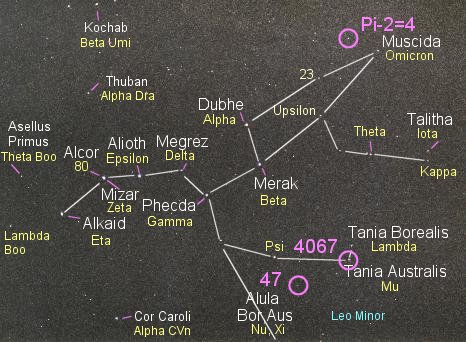 Not too many giant stars have been found with a planet. The best
known are Pollux (Beta Geminorum) and Ain (Epsilon Tauri). Here's another one.
Not too many giant stars have been found with a planet. The best
known are Pollux (Beta Geminorum) and Ain (Epsilon Tauri). Here's another one.
THE PLANET
The circle at upper right identifies the class K1 giant Pi-2 Ursae
Majoris in the constellation Ursa Major.
Pi-2 UMa has a massive planet that carries at least 7.1 times the
mass of Jupiter. It orbits the star with a period of 269.3 days
(0.74 years) at an average distance of 0.87 Astronomical Units (130
million kilometers, 80.8 million miles), about halfway between the
orbital sizes of Earth and Venus. A significant eccentricity takes
the planet from as far as 2.3 AU from its star to as close as 0.49
AU.
|
 Not too many giant stars have been found with a planet. The best
known are Pollux (Beta Geminorum) and Ain (Epsilon Tauri). Here's another one.
Not too many giant stars have been found with a planet. The best
known are Pollux (Beta Geminorum) and Ain (Epsilon Tauri). Here's another one.
 Not too many giant stars have been found with a planet. The best
known are Pollux (Beta Geminorum) and Ain (Epsilon Tauri). Here's another one.
Not too many giant stars have been found with a planet. The best
known are Pollux (Beta Geminorum) and Ain (Epsilon Tauri). Here's another one.